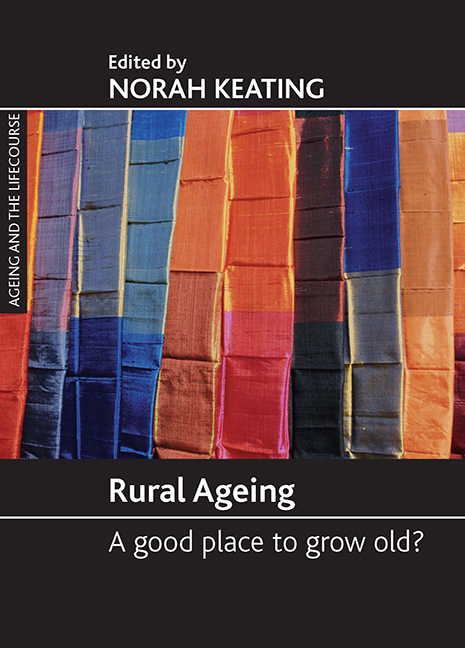Book contents
- Frontmatter
- Contents
- Foreword
- Acknowledgements
- Notes on contributors
- one A critical human ecology perspective on rural ageing
- two Crossing borders: lifecourse, rural ageing and disability
- three Rurality and ageing well: ‘a long time here’
- four The evolution of networks of rural older adults
- five Distance, privacy and independence: rural homecare
- six Respite for rural and remote caregivers
- seven Ageing, disability and participation
- eight Participation in rural contexts: community matters
- nine Staying connected: issues of mobility of older rural adults
- ten Ageing and social exclusion in rural communities
- eleven Age-friendly rural communities
- twelve Revisiting rural ageing
- References
- Index
- Other titles in the Ageing and the Lifecourse series
nine - Staying connected: issues of mobility of older rural adults
Published online by Cambridge University Press: 19 January 2022
- Frontmatter
- Contents
- Foreword
- Acknowledgements
- Notes on contributors
- one A critical human ecology perspective on rural ageing
- two Crossing borders: lifecourse, rural ageing and disability
- three Rurality and ageing well: ‘a long time here’
- four The evolution of networks of rural older adults
- five Distance, privacy and independence: rural homecare
- six Respite for rural and remote caregivers
- seven Ageing, disability and participation
- eight Participation in rural contexts: community matters
- nine Staying connected: issues of mobility of older rural adults
- ten Ageing and social exclusion in rural communities
- eleven Age-friendly rural communities
- twelve Revisiting rural ageing
- References
- Index
- Other titles in the Ageing and the Lifecourse series
Summary
Introduction
The increase in the number and proportion of older people, typically defined as 65 years of age and older, is one of the most profound changes affecting the industrialised, highly developed countries as well as less developed countries. In 2000, the estimated number of older people worldwide was 800 million, with a projected increase to 2 billion in 2050; 60% of those are estimated to live in rural areas (Eldar and Burger, 2000). When utilising the United Nations (UN, 2001) definition of rural as locales of fewer than 5,000 people, more than half the people in the world live in rural areas (CIESIN et al, 2005). The percentage of rural inhabitants, however, varies across countries, with greater percentages of people living in rural areas in Africa (62%) and Asia (61%), followed by Europe (32%), Oceania (26%), South America (25%) and North America (25%) (CIESIN et al, 2005).
The focus of this chapter is on the role that mobility plays in helping older rural adults stay connected within their community. Mobility refers to ‘the ability of the individual to gain access through movement to the facilities that he or she desires’ (Metz, 2003, p 375). It also serves as an important social connector. The quality and quantity of social interactions, feelings of isolation and loneliness, the structure of social networks and the support received from others all have been identified as predictors of health and well-being (see Cohen, 2004). Yet, while there has been a great deal of emphasis on the importance of such positive outcomes for older adults, there has been surprisingly little emphasis on the mechanisms by which older adults make their connections with people and services. Mobility, and especially driving, is a key facilitator to the integration of older rural adults into their communities.
In a seminal article, Carp (1988) conceptualised mobility as central to well-being in later life. She argued that mobility is a key determinant of the congruence or fit between life-maintenance needs such as food and clothing and the ability of older adults to live independently. Carp also hypothesised that mobility is equally important to what she called higher-order needs such as socialising, being engaged in community activities, or in worship. Carp's model is ecological, incorporating the resources and needs of older adults, as well as the social and community environments.
- Type
- Chapter
- Information
- Rural AgeingA Good Place to Grow Old?, pp. 87 - 96Publisher: Bristol University PressPrint publication year: 2008



